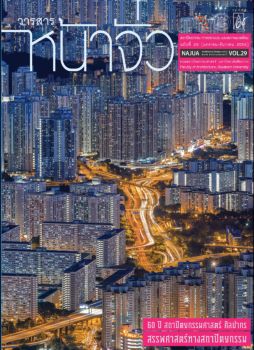ทางสัญจรเขียว: องค์ประกอบสำคัญในการพัฒนา เป็นโครงสร้างพื้นฐานเขียว
Keywords:
โครงสร้างพื้นฐานเขียว, ทางสัญจรเขียว, ระบบนิเวศเมือง, ความหลากหลายทางชีวภาพ, องค์กรปกครองส่วนท้องถิ่น, Green Infrastructure, Greenways, Urban ecology, Biodiversity, Local governmentAbstract
โครงสร้างพื้นฐานเขียว คือ พื้นที่สีเขียวหรือพื้นที่แหล่งนํ้าที่เชื่อมโยงถึงกันเป็นเครือข่าย ที่มีการออกแบบวางผังและการจัดการคุณค่าของทรัพยากรธรรมชาติ และความสัมพันธ์ของระบบ นิเวศเมือง บทความนี้มุ่งจะศึกษาเรื่องโครงข่ายทางสัญจรเขียวในแง่ของการพัฒนาแนวความคิด ยุทธศาสตร์การวางแผน และการนำไปปฏิบัติ ด้วยการเรียนรู้ประสบการณ์ในญี่ปุ่นและสิงคโปร์มา เป็นต้นแบบการประยุกต์ใช้ในพื้นที่ชุมชนเมืองพิมาย จังหวัดนครราชสีมา โดยการนำเสนอการสร้าง ทางสัญจรเขียวตามเส้นทางธรรมชาติและการใช้งานในชีวิตประจำวันในพื้นที่ ผนวกกับวิธีการส่งเสริม การตระหนักดา้ นการรับรูข้ องผูค้ นในกระบวนการพัฒนาทางสัญจรเขียวเมืองพิมาย ผลปรากฏว่า การพัฒนาเส้นทางสัญจรเขียวได้รับการตอบสนองจากคนในพื้นที่ อย่างไรก็ตามการคำนึงถึงลักษณะทาง ธรรมชาติและวัฒนธรรมในพื้นที่ถือเป็นปัจจัยสำคัญต่อการผนวกเส้นทางสัญจรเขียวให้เกิดการเชื่อม โยงกับพื้นที่สีเขียวเดิมทำให้เกิดเป็นเครือข่ายและกลายเป็นโครงสร้างพื้นฐานเขียวของเมือง
Greenways: an Important Element of Green Infrastructure
Nikhom Boonyanusith
Assistant Professor, Faculty of Engineering and Architecture, Rajamangala University of Technology Isan
Shiannfar Kung
Professor, Urban Planning Department, Planning and Design Collage, National Cheng Kung University, Taiwan
Hanlian Lin
Assistant Professor, Urban Planning Department, Planning and Design Collage, National Cheng Kung University, Taiwan
Green infrastructure is an interconnected blue-green space network that is planned and managed for its natural resource values and is related to urban ecology. This paper traces the conceptualization, planning strategy and implementation of the greenway network. The Singapore and Japan experiences provide models for greenway planning and implementation for Phimai town, Nakhon Ratchasima, Thailand. Newer greenways improvement technologies such as nature-oriented construction. And public involvement methods are emphasized in the Phimai greenways development process. The results showed that development of the greenways had been supported by nearby residents. However, it is suggested that making full use of the natural and cultural characteristics of the local areas are important to the integration of greenways in urban green infrastructure.





